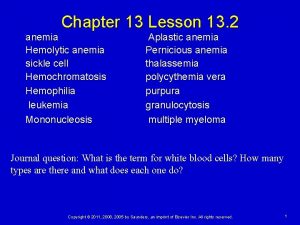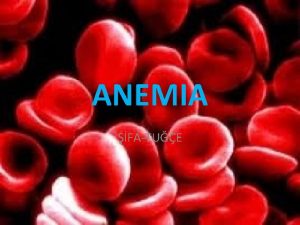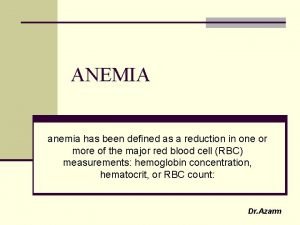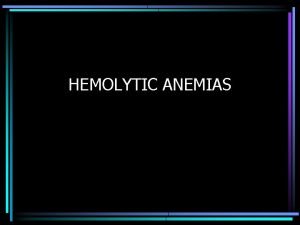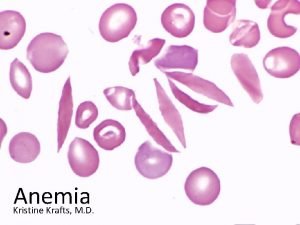Approach to Anemia Summary Approach to Anemia Case






































- Slides: 38

Approach to Anemia Summary

Approach to Anemia – Case 1 • 37 year old female patient of Caucasian origin referred to the Emergency Room because of anemia • Medical background: generally healthy, normal diet; during the last week treated with an antibiotic because of suspected pharyngitis • Complains of weakness and low-grade fever

Approach to Anemia – Case 1 n n n On examination: pallor, slight jaundice; spleen mildly enlarged, soft, tender No lymphadenopathy, no bleeding tendency, no glossitis Pulse 100, regular, blood pressure and oxygen saturation normal

Approach to Anemia – Case 1 n Laboratory evaluation - Set I: - Hemoglobin – 7. 9 gr% - MCV – 100 - RDW – 17 - WBC – normal - Platelets - normal

Approach to Anemia – Case 1 n n Interpretation: macrocytic anemia Differential diagnosis: - Megaloblastic anemia - Hemolytic anemia - Myelodysplastic syndrome/Aplastic anemia - Other

Approach to Anemia – Case 1 n Laboratory evaluation - Set II: - Reticulocytes – 14% - Corrected reticulocyte count: /% Retics X (measured to the expected Hb ratio)/ 14% x 7. 9/15 = 7. 4% - Reticulocyte Production Index (RPI): /Corrected reticulocyte count/shift correction factor/ 7. 4 / 2 = 3. 7 (>2)

Approach to Anemia – Case 1 n n Interpretation: hyperproliferative anemia Differential diagnosis: - Megaloblastic anemia? No - Myelodysplastic syndrome/Aplastic anemia? No - Hemolytic anemia? Yes

Approach to Anemia – Case 1 n n Laboratory evaluation - Set III: - LDH – high - Bilirubin – high (unconjugated) - Haptoglobin – low Diagnosis confirmed: Hemolytic anemia

Approach to Anemia – Case 1 n Hemolytic anemia – differential diagnosis: - Intra-corpuscular (hemoglobinopathy, enzymopathy) - Red cell membrane (cytoskeleton, PNH, spur cell anemia) - Extra-corpuscular (hypersplenism, mechanic hemolysis, immune hemolysis, toxic/infectious agents)

Approach to Anemia – Case 1 n Laboratory evaluation - Set IV: Blood smear - Anisocytosis (high RDW) - Polychromasia (reticulocytosis) - Spherocytes? - Ellyptocytes? - Bite cells? - Spur cells? - Schistocytes? - Sickle cells?


Approach to Anemia – Case 1 n Laboratory evaluation – Set V: - Direct anti-globulin (Coombs) test – Ig. G +3

Approach to Anemia – Case 1 Summary: - Mild splenomegaly, fever, jaundice - Macrocytic anemia - Reticulocytosis - Spherocytosis - Positive direct anti-globulin test Warm-type immune hemolytic anemia, possibly – drug related

Approach to Anemia An approach to anemia is based on asking 3 main questions: 1. MCV? 2. Reticulocyte count? (Bone marrow function) 3. Involvement of additional lineages?

Approach to Anemia n MCV: - Low: Iron deficiency Thalassemia trait Chronic disease Sideroblastic anemia - Normal: Iron deficiency (early) Chronic disease Renal failure

Approach to Anemia - High: Megaloblastic anemia Hemolytic anemia MDS / Aplastic anemia Drug-related Hypothyroidism Alcoholism Liver disease

Approach to Anemia n Reticulocyte count: - Adequte (RPI>2): Hemolytic anemias (most) Acute blood loss Liver disease - Inadequate (RPI<2): Iron deficiency Megaloblastic anemia Anemia of chronic disease Bone marrow failure (malignancy, chemotherapy, MDS/Aplastic anemia)

Approach to Anemia n Additional lineage(s) involvement: - Leukopenia: Malignancy Chemotherapy Hypersplenism Drug-related Megaloblastic anemia Aplastic anemia

Approach to Anemia - Thrombocytopenia: Malignancy Chemotherapy Hypersplenism Drug-related Megaloblastic anemia Aplastic anemia TTP DIC

Approach to Anemia n In addition, blood smear always needs to be carefully assessed: Schistocytes? Spherocytes? Target cells? Normoblasts? Spur cells (acanthocytes)? Burr cells? Malignant cells (leukemia, lymphoma)? Malaria parasites? Sickle forms?

Anemia With Low MCV and Low Reticulocytes n n Iron deficiency Hereditary defects in hemoglobin synthesis (thalassemia trait) n Defects in heme synthsis (sideroblastic anemia) n Anemia of chronic disease

Anemia With Normal MCV and Low Reticulocytes n Early or mild iron deficiency anemia n Chemotherapy n Anemia of chronic disease n Anemia of renal failure

Anemia with High MCV and Low Reticulocytes n Megaloblastic anemia n Myelodysplastic syndrome / Aplastic anemia n Drug-related anemia n Hypothyroidism n Alcoholism

Anemia with High Reticulocytes n n Low MCV: - Thalassemia Major (some cases) - Spherocytosis High MCV: - Sickle cell anemia - G-6 PD deficiency - Immune hemolytic anemia - Malaria infection

Anemia with Leukopenia and/or Thrombocytopenia n n Low reticulocytes: - Aplastic anemia/Myelodysplastic syndrome - Chemotherapy - Alcoholism - Megaloblastic anemia High reticulocytes: - TTP / DIC - Hypersplenism

Approach to Anemia – Case 2 63 year old male patient presented to your clinic with weakness and anemia; generally healthy, no permanent medications. On examination: afebrile, normal pulse and blood pressure. No hepatosplenomegaly and lymphadenopathy. Scattered purpura over lower extremities and chest.

Approach to Anemia – Case 2 n Laboratory evaluation - Set I:

Approach to Anemia – Case 2 n n Interpretation: macrocytic anemia with thrombocytopenia Differential diagnosis:

Approach to Anemia – Case 2 n Laboratory evaluation - Set II:

Interpretation: High MCV, Low RPI Differential Diagnosis: n Megaloblastic anemia n Myelodysplastic syndrome n Aplastic anemia n Drug-related n Alcoholism

Approach to Anemia – Case 2 n Laboratory evaluation - Set III: - B 12 and Folate levels Thorough history taking: alcohol? medications?

Approach to Anemia – Case 2 n Laboratory evaluation - Set IV:


Approach to Anemia – Case 2 n Laboratory evaluation - Set V:


Ringed Sideroblast Iron

Approach to Anemia – Case 2 n Summary: - Macrocytic anemia - Thrombocytopenia - Low RPI - Dysplastic maturation (peripheral smear, bone marrow) - Normal B 12 and Folate levels Myelodysplastic syndrome

Table 29 -05 Copyright © 2005 Elsevier Inc. (USA) All rights reserved.
 Pernicious anemia vs megaloblastic anemia
Pernicious anemia vs megaloblastic anemia Megaloblastic anemia lab values
Megaloblastic anemia lab values Difference between megaloblastic and pernicious anemia
Difference between megaloblastic and pernicious anemia Best worst and average case
Best worst and average case Anemia case study
Anemia case study Long case and short case
Long case and short case Worst case of binary search
Worst case of binary search Glennan building cwru
Glennan building cwru Bubble sort algorithm pseudocode
Bubble sort algorithm pseudocode It project failure case study
It project failure case study Bubble sort best case and worst case
Bubble sort best case and worst case Bubble sort best case and worst case
Bubble sort best case and worst case Saa case example
Saa case example Thyroid cancer: a case-based approach
Thyroid cancer: a case-based approach Humanistic case conceptualization example
Humanistic case conceptualization example Virtual circuit and datagram network
Virtual circuit and datagram network Theoretical models of counseling
Theoretical models of counseling Waterfall and shower strategy
Waterfall and shower strategy Multiple approach-avoidance
Multiple approach-avoidance Bandura's reciprocal determinism
Bandura's reciprocal determinism Approach approach
Approach approach Traditional approach to system development
Traditional approach to system development Tony wagner's seven survival skills
Tony wagner's seven survival skills Mangold case summary
Mangold case summary Goodrickes v hall and another
Goodrickes v hall and another Donoghue v stevenson case summary
Donoghue v stevenson case summary Clements v london and north western railway
Clements v london and north western railway Donoghue v stevenson case summary
Donoghue v stevenson case summary Raja rani vs prem adib
Raja rani vs prem adib Metallgesellschaft case summary
Metallgesellschaft case summary Non charitable trust
Non charitable trust Dano case
Dano case Narrative recording in social work
Narrative recording in social work National land finance cooperative society
National land finance cooperative society Asylum case summary
Asylum case summary Boardman v phipps case summary
Boardman v phipps case summary Tinker vs des moines case summary
Tinker vs des moines case summary Harvey vs facey case summary
Harvey vs facey case summary Mikromandibula
Mikromandibula
